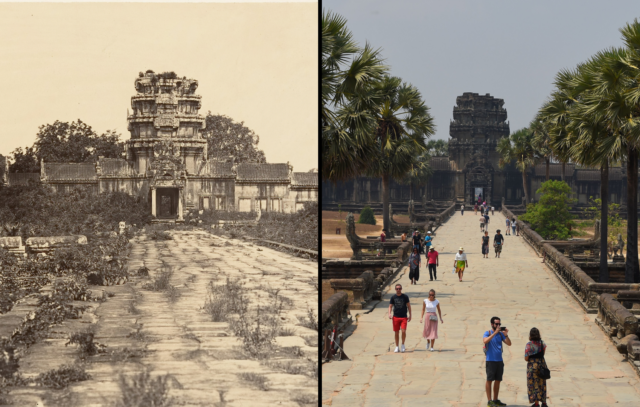Many historical sites around the world were built with purpose but fell into abandonment and disrepair over time. Archaeological discovery and restoration work has revitalized many of these sites, returning them to their former glory. Compare these photographs of historical sites at the time of their discovery with their present-day counterparts to see how much has changed over time!
Chichén Itzá

The Chichén Itzá, an ancient city in Yucatan, Mexico, was first established between 415 and 435 AD. It was abandoned in 1440 after the native Yucatec Maya revolted against the rulers of the Itzá. American explorer John Lloyd Stephens re-discovered it, but excavations didn’t begin on the site until 1942. Now, it is a UNESCO World Heritage Site and is one of the New Seven Wonders of the World.
Tikal

Tikal, an ancient Mayan city, was at its height the economic hub of the civilization and housed more than 60,000 people. It is believed to have been settled as early as 600 BC, though many of the buildings are believed to have been established between 250 and 900 AD. Why the city was eventually abandoned is still unclear, and the first expedition to the ruins wasn’t until 1848. Restoration of the ancient city took place between 1956 and 1966, and it became a UNESCO World Heritage Site shortly afterward.
Stonehenge

Believed to date as far back as 4,500 years ago, the origins and purpose of Stonehenge remain a mystery. The positioning of the large stones carefully aligns with the movements of the sun, suggesting that it could have served as a Neolithic calendar, while others believe it was a burial site or place of worship. While it was never really “abandoned,” Stonehenge was excavated and restored as early as the 1880s and has been maintained ever since.
Mayan Temple of the Inscriptions

Another ancient Mayan city, Palenque, was established in 432 AD and is home to the Temple of Inscriptions, the largest Mayan Funerary pyramid. This city was significantly smaller than others, housing a mere 6,000 people, but has been invaluable for research of the ancient Mayan civilization. After having been long abandoned, the city was re-discovered in 1,567 by Father Pedro Lorenzo de la Nada and was later dubbed a UNESCO World Heritage Site in 1987.
The Great Ziggurat of Ur

Constructed in Mesopotamia around 2,100 BC, the Great Ziggurat of Ur was built from 720,000 33-pound baked bricks. At the top of the massive structure, a temple was constructed to honor the moon goddess Nanna, but after centuries has been lost. The city was abandoned after the Euphrates River changed course, leaving residents without water. Excavations of the area began in the 1920s, and the structure saw its second restoration after 2,400 years – the first having been completed in the sixth century BC by the Babylonian King Nabodinus.
Angkor

The Khmer Empire’s capital city of Angkor was first built in the ninth century and covered over 400 square miles, with about 750,000 people calling it home. Why such a massive city was abandoned is still a mystery, but knowledge and use of the area continued by locals. Restoration of the city began in 1859 after it was found by French explorer Francois Mouhot, and it became a UNESCO World Heritage Site in 1992. It is a massive tourist site, as it houses one of the largest religious buildings in the world, the Angkor Wat.
The Great Sphinx of Giza

The Great Sphinx of Giza is one of the most recognizable historical sites in the world, built around 2.540 BC. The structure has the body of a lion and the head of a man, and, notably, the nose of the Sphinx was removed, with different theories circulating as to what happened to it. For centuries, the head of the Sphinx was all that was visible until the rest of the monument was excavated in 1,930 by Egyptian archaeologist Selim Hassan. However, despite efforts to restore and preserve the Sphinx, it continues to deteriorate.
Borobudur Temple

Serving as the world’s largest Buddhist temple, Borobudur was built around 800 AD and houses 500 Buddha statues at the top. It was abandoned sometime in the 1,500s, leaving the site to the forces of nature. It wasn’t until the 19th century when the British Governor of Java had the temple excavated. Unfortunately, during this time, many of the stones and statues were stolen for private collections. However, it became a UNESCO World Heritage Site in 1968, which saw the temple restored to its former glory through cleaning and preservation tactics.
Read more: Take a Trip Back In Time With These Photos of Imperial Russia’s Winter Palace
The most incredible thing about all of these historical sites is their ability to incite awe in visitors for millennia.
